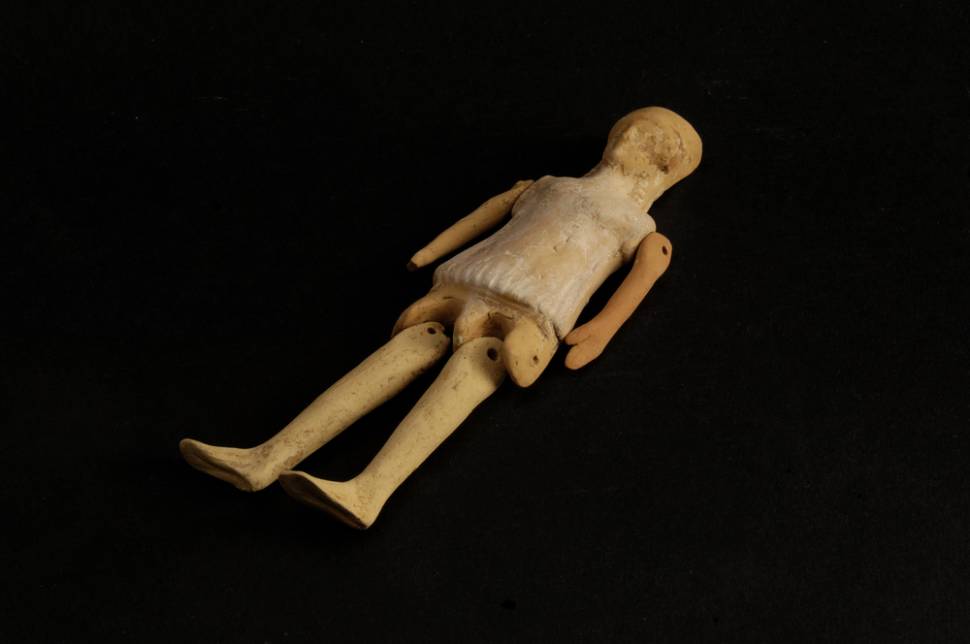The First ”Barbie Doll” In History And The Amazing Findings

If someone told you that in Ancient Rome, girls played with Barbie dolls too, would you believe them? Of course not, because Barbie dolls were first made in 1959. A dig in Rome, however, comes to show us that this is not the case. The girls in Ancient Rome also played with dolls like Barbie, of course not as we know Barbie today.
In 1889, five sarcophagi were found during the construction of the Italian Ministry of Justice and a bridge across the Tiberius River. The skeleton of a young woman, Creperia Trypaina (her name was an inscription on the outside of the sarcophagus), was found in one sarcophagus. The woman was from a wealthy family because she had been buried with rich grave goods (gold rings, earrings, etc.). Still, the most important possession from an archaeological point of view in the sarcophagus was not the Golden grave goods but a doll.
The doll was of female sex and around 9 inches long. It was made entirely of ivory, a material too expensive for the time. The most surprising part, however, is not the material of manufacture of the doll but the details of the doll. The head and body had been crafted in the same piece of ivory, while her arms and legs were in separate sections. The hands and feet of the doll were joined to the rest of the body with a nail, so they were given the opportunity to blink. The doll is so well-made that the hands open at the elbows and the feet at the knees. The physiological details of the construction are so impressive that the doll seems to have been constructed centuries after its original construction.
The features of the doll’s face have such detail that it is just like a portrait. The doll seems to have a tiny gold ring with a key on her finger. Similar rings, in a standard size, were worn by the rich Romans, and with the keys opened their jewelry boxes. Next to the doll was found a small box also made of ivory was found. Jewels and accessories of the doll were found inside the box. Another tiny ring, tiny pearls from her earrings, remains of a tiny chain, two tiny mirrors, and bone combs were all in the box. Due to the findings of the doll, we can assume that Creperia Trypaina played with her doll, blinked the hands and feet of the doll, wore jewelry, and dressed her in front of her mirrors.
The doll found in Rome is very similar in style to ancient Greek toys called the Plangons. The craftsmen made the Plangons from wood, ivory, and especially clay. The construction of the Plangona was done in the coroplast laboratories. They were made by hand, or the craftsman created a basic form in a mold and then added the details. A thread joined their arms and legs with the main body. Then the craftsman covered the toy with a white coating and baked it in the oven. Finally, color was added to the doll. Sometimes the doll’s clothes were painted; other times, the girls dressed them in sneakers. In any case, the details and features of the doll from Rome rank her as the first” Barbie” in history.
Children’s need for toys remains the same whether we are talking about antiquity or we are talking about modern times, and the archeological findings prove this. It is also interesting that the doll found in Rome had the characteristics of its owner. For example, the ring with the key is an element in women’s real life. So, the toy would have to resemble real life.
Have you read?
From nearshoring boom to sustainable ally-shoring with Mexico by Thomas Michael Hogg.
Remote Work and its effects on Work-Life Balance.
Generative AI: The Force Surging AI to Cultural Prominence by Brian Wallace.
Bring the best of the CEOWORLD magazine's global journalism to audiences in the United States and around the world. - Add CEOWORLD magazine to your Google News feed.
Follow CEOWORLD magazine headlines on: Google News, LinkedIn, Twitter, and Facebook.
Copyright 2025 The CEOWORLD magazine. All rights reserved. This material (and any extract from it) must not be copied, redistributed or placed on any website, without CEOWORLD magazine' prior written consent. For media queries, please contact: info@ceoworld.biz








